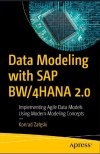Data Modeling with SAP BW/4HANA 2.0
Автор: Konrad Zaleski (2021)

This book is for anyone who wants to gain knowledge about the SAP BW/4HANA platform. In this book, readers will learn about new functionalities and components of SAP BW/4HANA and will get practical experience implementing agile data models using modern modeling concepts. This book is recommended especially for BI developers, consultants, and team leaders who have worked on previous versions of SAP BW, who are planning to upgrade their system to the SAP BW/4HANA release, or who have already started to explore SAP BW/4HANA and want to get a better understanding of what has changed and what the new options are.
This book contains the following chapters:
Chapter 1: SAP BW/4HANA Modeling Objects
This chapter gives a technical introduction to the SAP HANA and SAP BW/4HANA worlds. It walks readers through the main modeling objects, highlights new functionalities, and explains how to create these objects.
Chapter 2: Modeling Concepts
This chapter introduces five modeling concepts, highlighting their usage as well as the pros and cons of each. The next chapters will use these modeling concepts to implement solutions that meet the requirements of the given business scenarios.
Chapter 3: Publishing HANA Objects Through BW/4HANA
This chapter will explain how to expose HANA objects through the BW/4HANA layer without creating a persistent acquisition layer. In addition, readers will learn how to pass input parameters between BW queries and HANA calculation views.
Chapter 4: Creating a Field-Based Data Model
This chapter presents how to create field-based data models on top of HANA objects. After this chapter, readers will know how to implement star schema models without using InfoObjects.
Chapter 5: Creating a Hybrid Data Model
This chapter explains the hybrid modeling approach used to mix a field-based approach with SAP InfoObjects. With this approach, you will be able to enhance your model with additional information even though it is not available in the source objects.
Chapter 6: Integrating SAP and Non-SAP Data into a Single Data Model
This chapter demonstrates how to combine SAP and non-SAP data to create a single integrated data model that provides a 360-degree view on the data.
To understand each aspect of the modern modeling concepts, I recommend starting with Chapter 1 and reading through the book sequentially.
Автор: Konrad Zaleski (2021)

This book is for anyone who wants to gain knowledge about the SAP BW/4HANA platform. In this book, readers will learn about new functionalities and components of SAP BW/4HANA and will get practical experience implementing agile data models using modern modeling concepts. This book is recommended especially for BI developers, consultants, and team leaders who have worked on previous versions of SAP BW, who are planning to upgrade their system to the SAP BW/4HANA release, or who have already started to explore SAP BW/4HANA and want to get a better understanding of what has changed and what the new options are.
This book contains the following chapters:
Chapter 1: SAP BW/4HANA Modeling Objects
This chapter gives a technical introduction to the SAP HANA and SAP BW/4HANA worlds. It walks readers through the main modeling objects, highlights new functionalities, and explains how to create these objects.
Chapter 2: Modeling Concepts
This chapter introduces five modeling concepts, highlighting their usage as well as the pros and cons of each. The next chapters will use these modeling concepts to implement solutions that meet the requirements of the given business scenarios.
Chapter 3: Publishing HANA Objects Through BW/4HANA
This chapter will explain how to expose HANA objects through the BW/4HANA layer without creating a persistent acquisition layer. In addition, readers will learn how to pass input parameters between BW queries and HANA calculation views.
Chapter 4: Creating a Field-Based Data Model
This chapter presents how to create field-based data models on top of HANA objects. After this chapter, readers will know how to implement star schema models without using InfoObjects.
Chapter 5: Creating a Hybrid Data Model
This chapter explains the hybrid modeling approach used to mix a field-based approach with SAP InfoObjects. With this approach, you will be able to enhance your model with additional information even though it is not available in the source objects.
Chapter 6: Integrating SAP and Non-SAP Data into a Single Data Model
This chapter demonstrates how to combine SAP and non-SAP data to create a single integrated data model that provides a 360-degree view on the data.
To understand each aspect of the modern modeling concepts, I recommend starting with Chapter 1 and reading through the book sequentially.
Скрытое содержимое могут видеть только пользователи групп(ы): Premium, Местный, Свои
